BPLCB Module Datasheet
Last Updated on : 2024-06-14 07:11:50download
BPLCB is a low-power embedded Bluetooth module that Tuya has developed. Embedded with the Bluetooth communication protocol stack and rich library functions, it mainly consists of a highly integrated Bluetooth chip (PHY6222) and a few peripheral circuits.
Product overview
BPLCB also contains a low-power 32-bit MCU, a Bluetooth LE 5.0/2.4-G Radio, 512-KB flash memory, 64-KB SRAM, and 2 reusable I/O ports.
Features
- Embedded with a low-power 32-bit MCU, which can also function as an application processor.
- Working voltage: 1.8 to 3.6V
- Peripheral: 2 PWMs
- Bluetooth RF features
- Bluetooth LE 4.2/5.1
- The RF data rate can be up to 1 Mbps.
- TX power: +8 dBm
- RX sensitivity: -97 dBm@ 1 Mbps
- Embedded hardware AES encryption
- External antenna
- Working temperature: -40℃ to +105℃
Applications
- Smart LED
- Smart home
Module interfaces
Dimensions and footprint
BPLCB has 5 pins in total for plug-in assembly.
The dimensions of BPLCB are 7.5±0.35 mm (W)×10.9±0.35 mm (L) ×2.3±0.15mm (H). The thickness of the PCB is 1.0±0.1 mm.
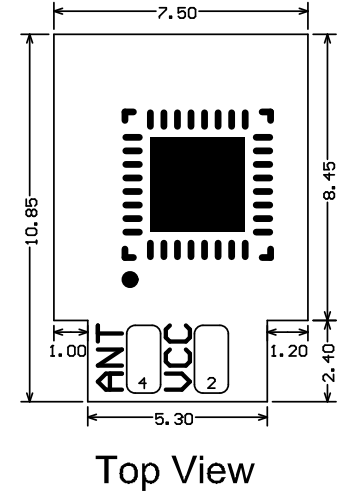
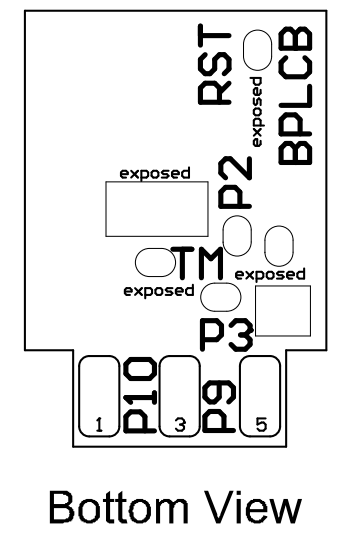
Pin definition
The definitions of pins are shown in the following table:
| Serial number | Symbol | I/O type | Function |
|---|---|---|---|
| 1 | GND | P | Power supply reference ground |
| 2 | VCC | P | Power input pin |
| 3 | P10 | I/O | Common I/O interface, which can be used as PWM output of the LED drive and UART_RX, and corresponds to P10 of the IC |
| 4 | ANT | I/O | It is the port for inputting and outputting the RF signal and corresponds to ANT of the IC. |
| 5 | P9 | I/O | Common I/O interface, which can be used as PWM output of the LED drive and UART_TX, and corresponds to P9 of the IC |
| Test point | RST | I/O | Reset pin |
| Test point | TM | I/O | Mode selection pin It is pulled high in burning mode, but pulled down or not connected to anything in other modes. |
| Test point | P2 | I/O | It is only used for debugging. |
| Test point | P3 | I/O | It is only used for debugging. |
Note:
- P indicates a power supply pin and I/O indicates an input/output pin.
- If you have any special requirements on the light color controlled by the PWM output, please contact Tuya business personnel.
Electrical parameters
Absolute electrical parameters
| Parameter | Description | Minimum value | Maximum value | Unit |
|---|---|---|---|---|
| Ts | Storage temperature | -65 | 150 | ℃ |
| VCC | Power supply voltage | -0.3 | 3.9 | V |
| ESD voltage (human body model) | TAMB-25℃ | - | 2 | kV |
| ESD voltage (machine model) | TAMB-25℃ | - | 0.5 | kV |
Working conditions
| Parameter | Description | Minimum value | Typical value | Maximum value | Unit |
|---|---|---|---|---|---|
| Ta | Working temperature | -40 | - | 105 | ℃ |
| VCC | Working voltage | 1.8 | 3.3 | 3.6 | V |
| VIL | I/O low-level input | VSS | - | VCC*0.3 | V |
| VIH | I/O high-level input | VCC*0.7 | - | VCC | V |
| VOL | I/O low-level output | VSS | - | VCC*0.1 | V |
| VOH | I/O high-level output | VCC*0.9 | - | VCC | V |
Power consumption in working mode
| Symbol | Conditions | Maximum value (Typical value) | Unit |
|---|---|---|---|
| Itx | Constantly transmit with the output power of 8 dBm | 24 | mA |
| Irx | Constantly receive | 15 | mA |
| IDC | Average value in mesh networking state | 13 | mA |
| IDC | Peak value in mesh networking state | 23 | mA |
Precautions for using magnetic fastening lights
For some customers’ magnetic fastening light solutions, during use, it is found that a strong radiation interference exists on the three wires driving the LED of the light. When the three wires are close to the module, it might cause the module to frequently go offline or make it difficult to pair at close range. Therefore, we recommend reserving a 10nF capacitor to ground on each of the three lines driving the LED, helping reduce the radiation interference of the driving lines to the module.
RF parameters
Basic RF features
| Parameter | Description |
|---|---|
| Working frequency | 2.4 GHz ISM band |
| Wireless standard | Bluetooth LE 4.2/5.0 |
| Data transmission rate | 1 Mbps |
| Antenna type | External antenna |
RF output power
| Parameter | Minimum value | Typical value | Maximum value | Unit |
|---|---|---|---|---|
| Average RF output power | -20 | 8 | 10 | dBm |
| Bandwidth of 20-dB modulation signal (1M) | - | 2500 | - | KHz |
RF receiving sensitivity
| Parameter | Minimum value | Typical value | Maximum value | Unit |
|---|---|---|---|---|
| RX sensitivity 1 Mbps | - | -97 | - | dBm |
| Frequency offset error 1 Mbps | -250 | - | +300 | KHz |
| Co-channel interference suppression | - | -10 | - | dB |
Antenna information
Antenna type
BPLCB uses an external monopole sub-antenna. Its gain and dimensions can be customized according to customers’ needs.
Antenna interference reduction
To ensure the best RF performance, it is recommended that the antenna be at least 15 mm away from other metal parts. If metal materials wrap around the antenna, the wireless signal will be greatly attenuated, thereby deteriorating the RF performance. When designing the finished product, please leave enough space for the antenna.
Packaging information and production instructions
Mechanical dimensions and dimensions of the back of the pad


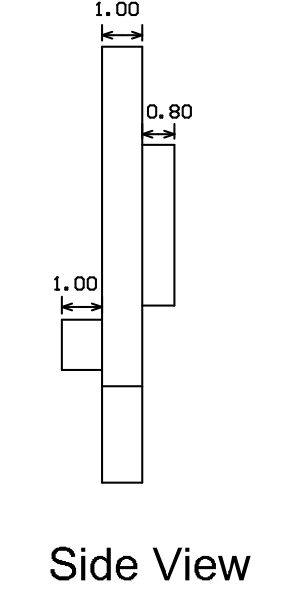
Recommended PCB footprint
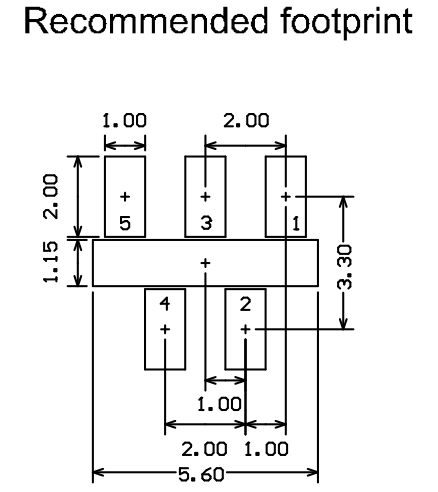
Note: The default outline dimension tolerance is ±0.35 mm, and the critical dimension tolerance is ±0.1 mm. If you have specific requirements on dimensions, specify them clearly in the datasheet after communication.
Production instructions
- For the Tuya in-line module, wave soldering is most preferred and manual soldering is less preferred. After being unpacked, the module must be soldered within 24 hours. Otherwise, it must be put into the drying cupboard where the RH is not greater than 10%; or it needs to be packaged under vacuum again and record the exposure time (the total exposure time cannot exceed 168 hours).
- Wave soldering devices and materials:
- Wave soldering equipment
- Wave soldering fixture
- Constant-temperature soldering iron
- Tin bar, tin wire, and flux
- Thermal profiler
- Baking devices:
- Cabinet oven
- Anti-electrostatic and heat-resistant trays
- Anti-electrostatic and heat-resistant gloves
- The module needs to be baked in the following cases:
- The packaging bag is damaged before unpacking.
- There is no humidity indicator card (HIC) in the packaging bag.
- After unpacking, circles of 10% and above on the HIC become pink.
- The total exposure time has lasted for over 168 hours since unpacking.
- More than 12 months have passed since the sealing of the bag.
- Baking settings:
- Temperature: 40°C and ≤ 5% RH for reel package and 125°C and ≤5% RH for tray package (please use the heat-resistant tray rather than a plastic container)
- Time: 168 hours for reel package and 12 hours for tray package
- Alarm temperature: 50°C for reel package and 135°C for tray package
- Production-ready temperature after natural cooling: < 36°C
- Re-baking situation: If a module remains unused for over 168 hours after being baked, it needs to be baked again.
- If a batch of modules is not baked within 168 hours, do not use the wave soldering to solder them. Because these modules are Level-3 moisture-sensitive devices, they are very likely to get damp when exposed beyond the allowable time. In this case, if they are soldered at high temperatures, it may result in device failure or poor soldering.
- In the whole production process, take electrostatic discharge (ESD) protective measures.
- To guarantee the quality of products, you must pay attention to the following items: The amount of soldering flux, the height of the wave peak, whether the tin slag and copper content in the wave soldering tank exceed standards, whether the window and thickness of the wave soldering fixture are appropriate, and whether the wave soldering oven temperature curve is appropriate.
Recommended oven temperature curve and temperature
Set oven temperatures according to the following temperature curve of wave soldering. The peak temperature is 260°C±5°C.
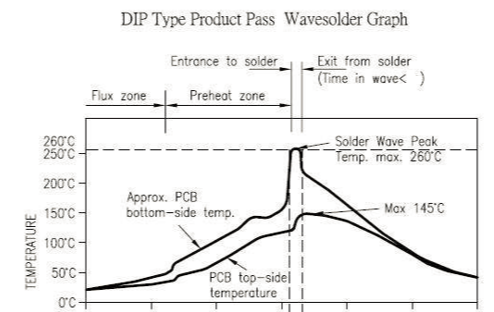
Recommended soldering temperature:
| Suggestions on oven temperature curve of wave soldering | Suggestions on manual soldering temperature | ||
|---|---|---|---|
| Preheat temperature | 80 to 130 °C | Soldering temperature | 360±20°C |
| Preheat time | 75 to 100s | Soldering time | <3s/point |
| Peak contact time | 3 to 5s | NA | NA |
| Temperature of tin cylinder | 260±5°C | NA | NA |
| Ramp-up slope | ≤2°C/s | NA | NA |
| Ramp-down slope | ≤6°C/s | NA | NA |
Storage conditions
Storage conditions for a delivered module:
-
The moisture-proof bag is placed in an environment where the temperature is below 40°C and the relative humidity is lower than 90%.
-
The shelf life of a dry-packaged product is 12 months from the date when the product is packaged and sealed.
-
There is a humidity indicator card (HIC) in the packaging bag.
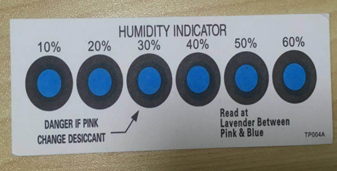

MOQ and packaging information
| Product number | MOQ (pcs) | Packing method | Modules per reel | Reels per carton |
|---|---|---|---|---|
| BPLCB | 8000 | Tape reel | 2000 | 4 |
Appendix-Statement
FCC Caution: Any changes or modifications not expressly approved by the party responsible for compliance could void the user’s authority to operate this device.
This device complies with Part 15 of the FCC Rules. Operation is subject to the following two conditions: (1) This device may not cause harmful interference, and (2) this device must accept any interference received, including interference that may cause undesired operation.
Note: This device has been tested and found to comply with the limits for a Class B digital device, according to part 15 of the FCC Rules. These limits are designed to provide reasonable protection against harmful interference in a residential installation. This device generates, uses, and can radiate radio frequency energy and, if not installed and used following the instructions, may cause harmful interference to radio communications. However, there is no guarantee that interference will not occur in a particular installation.
If this device does cause harmful interference to radio or television reception, which can be determined by turning the device off and on, the user is encouraged to try to correct the interference by one or more of the following measures:
- Reorient or relocate the receiving antenna.
- Increase the separation between the device and receiver.
- Connect the device to an outlet on a circuit different from that to which the receiver is connected.
- Consult the dealer or an experienced radio/TV technician for help.
Radiation Exposure Statement
This device complies with FCC radiation exposure limits set forth for an uncontrolled rolled environment. This device should be installed and operated with a minimum distance of 20cm between the radiator and your body.
Important Note
This radio module must not be installed to co-locate and operate simultaneously with other radios in the host system except by following FCC multi-transmitter product procedures. Additional testing and device authorization may be required to operate simultaneously with other radios.
The availability of some specific channels and/or operational frequency bands are country dependent and are firmware programmed at the factory to match the intended destination. The firmware setting is not accessible to the end-user.
The host product manufacturer is responsible for compliance with any other FCC rules that apply to the host not covered by the modular transmitter grant of certification. The final host product still requires Part 15 Subpart B compliance testing with the modular transmitter installed.
The end-user manual shall include all required regulatory information/warnings as shown in this manual, including “This product must be installed and operated with a minimum distance of 20 cm between the radiator and user body”.
This device has got an FCC ID: 2ANDL-BPLCB. The end product must be labeled in a visible area with the following: “Contains Transmitter Module FCC ID: 2ANDL-BPLCB”.
This device is intended only for OEM integrators under the following conditions:
The antenna must be installed such that 20cm is maintained between the antenna and users, and the transmitter module may not be co-located with any other transmitter or antenna.
As long as the 2 conditions above are met, further transmitter tests will not be required. However, the OEM integrator is still responsible for testing their end-product for any additional compliance requirements required with this module installed.
Declaration of Conformity European Notice

Hereby, Hangzhou Tuya Information Technology Co., Ltd declares that this module product is in compliance with essential requirements and other relevant provisions of Directive 2014/53/EU, 2011/65/EU. A copy of the Declaration of Conformity can be found at https://www.tuya.com.

This product must not be disposed of as normal household waste, in accordance with the EU directive for waste electrical and electronic equipment (WEEE-2012/19/EU). Instead, it should be disposed of by returning it to the point of sale, or to a municipal recycling collection point.
The device could be used with a separation distance of 20cm from the human body.
Is this page helpful?
YesFeedbackIs this page helpful?
YesFeedback





